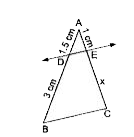संलग्न आकृति में, ABCD एक समलंब है जिसमें CD || AB है तथा इसके विकर्ण बिंदु 0 पर प्रतिच्छेद करते हैं। यदि AO = (2x + 1) cm, OC = (5x -7) cm, DO = (7x-5) cm तथा OB = (7x + 1) cm हो, तो x का मान ज्ञात कीजिए।

The correct Answer is:x = 2
Topper's Solved these Questions
- त्रिभुज BOOK - BHARATI BHAWANCHAPTER - त्रिभुज EXERCISE - प्रश्नमाला 7B
20 Videos
- त्रिभुज BOOK - BHARATI BHAWANCHAPTER - त्रिभुज EXERCISE - प्रश्नमाला 7C
14 Videos
- त्रिभुज BOOK - BHARATI BHAWANCHAPTER - त्रिभुज EXERCISE - प्रश्नमाला 7E (बहुवैकल्पिक प्रश्न) सही विकल्प का चयन करें।
17 Videos
- त्रिकोणमितीय सर्वसमिकाएँ BOOK - BHARATI BHAWANCHAPTER - त्रिकोणमितीय सर्वसमिकाएँ EXERCISE - प्रश्नमाला 13C (बहुवैकल्पिक प्रश्न )
20 Videos
- दो चरों वाले रैखिक समीकरण - युग्म BOOK - BHARATI BHAWANCHAPTER - दो चरों वाले रैखिक समीकरण - युग्म EXERCISE - प्रश्नमाला 3F (बहुवैकल्पिक प्रश्न)
27 Videos
Similar Questions
बताइए कि निम्नांकित आकृति में दिए गए त्रिभुजों के युग्मों में से कौन-से युग्म समरूप - हैं। उस समरूपता कसौटी को लिखिए जिसका प्रयोग आपने उत्तर देने में किया है, साथ ही समरूप त्रिभुजों को सांकेतिक रूप में व्यक्त कीजिए।

View Solutionदिया है कि ΔABC~ΔPQR है, यदि ABPQ=13 है, तो ar(ΔABC)ar(ΔPQR) ज्ञात कीजिए।
View Solutionदी गई आकृति में, यदि DE||BC है, तो x बराबर है

View Solutionयदि sinA+sin2A=1 है, तो व्यंजक (cos2A+cos4A) का मान है
View Solutionयदि 2 x + 3y = 12 तथा 3 x - 2y = 5 है, तो
View SolutionIn the adjoining figure,ABCD is a trapezium in which CD||AB and its diagonals intersect at O.If AO=(5x-7)cm,OC=(2x+1)cm,DO=(7x-5)cm and OB=(7x+1)cm, find the value of x.
View SolutionDetermine the point of symmetry of a regular hexagon.
View SolutionIn the figure above (not to scale), ¯¯¯¯¯¯AB⊥¯¯¯¯¯¯CDandAD is the bisector of ∠BAE.AB=3cm and AC=5cm. Find CD.
View SolutionIn the following figures, PT=4 cm , TQ=6cm and RT=3 cm , then TS=_______________.
View SolutionIn the following figure (not to scale) , ABCD is an isosecles trapezium. overline(AB)||overline(CD), AB=9cm and CD =12 CM, AP:PD =BQ:QC=1:2 . Find PQ.
View SolutionFind the area of the shaded region, given that the radius of each circle is equal to 5 cm.
View SolutionConstruct a quadrilateral ABCD in which AB =4.6 cm , BC=2.6 cm, CD=3.5 cm, AD=2.6 cm , and the diagonal AC=4.9 cm.
ltimg src="https://d10lpgp6xz60nq.cloudfront.net/physics_images/PS_MATH_VII_C05_S01_019_Q01.png" width="80%"gt
View SolutionMatch the following Column A to Column B

View SolutionMatch the following Column A to Column B

View SolutionMatch the following Column A to Column B

View SolutionThe inequation represented by the graph given below is :
View Solution
